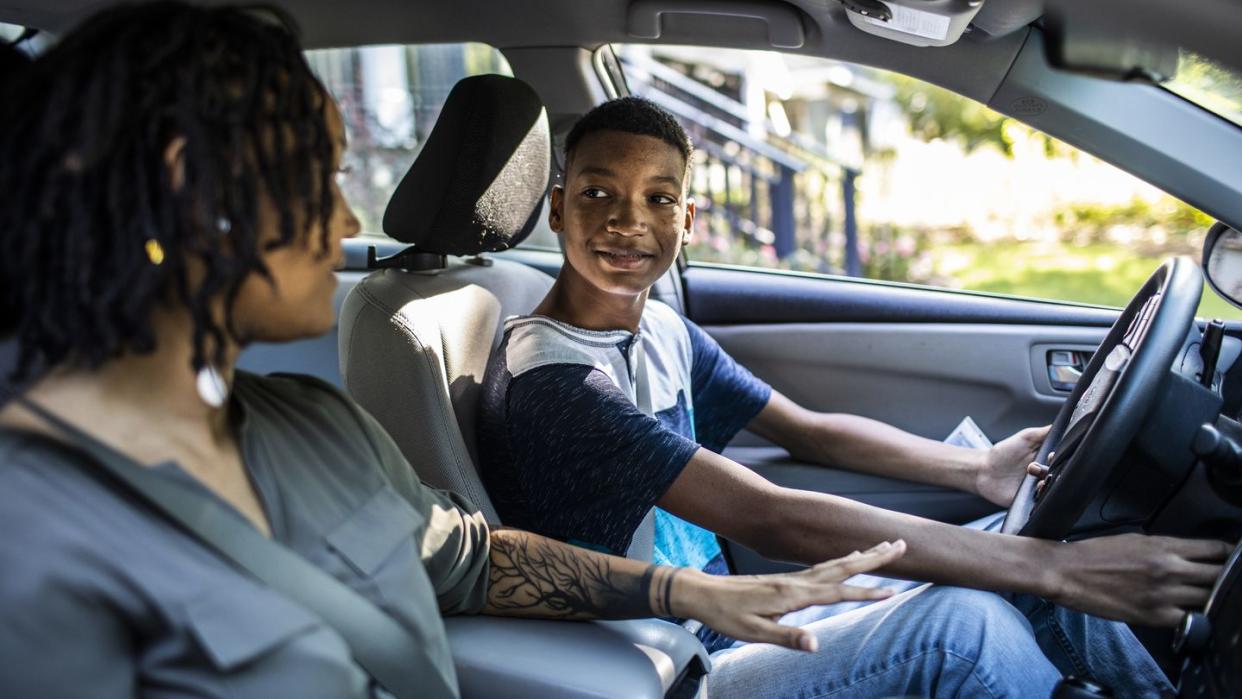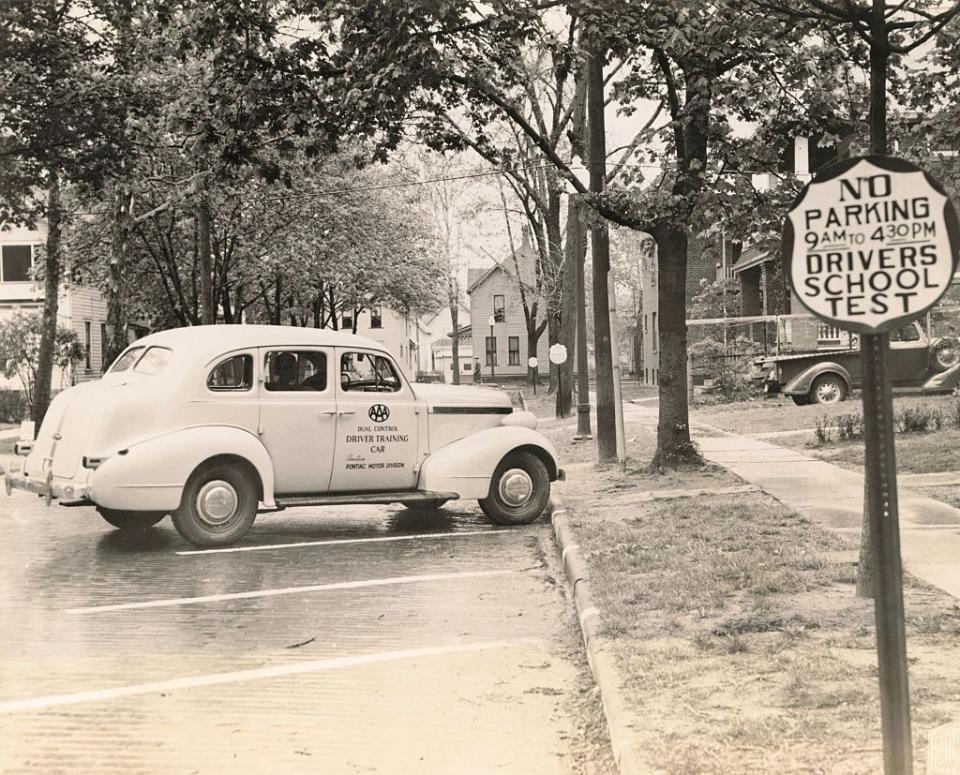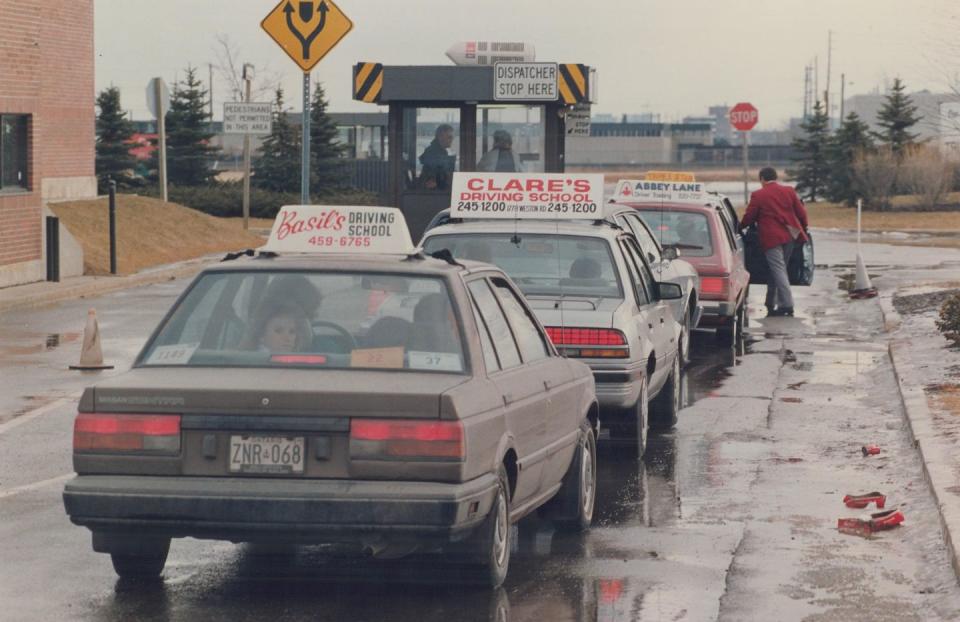Free Driver's Ed Programs Are Disappearing. But Are Parents Really the Best Teachers?

"Hearst Magazines and Yahoo may earn commission or revenue on some items through these links."
[table-of-contents] stripped
My 15-year-old daughter had just completed the first portion of her driver’s ed class (including six hours of on-the-road training) when she asked to drive home from her softball practice.
After a moment of mom-whiplash — my baby! — I shook it off, knowing this needed to become the new normal. Michigan, where we live, requires drivers under 18 who get a learner’s permit to log a whopping 50 hours of driving practice time with a parent in the car before they can qualify for a license at age 16.
So as I adjusted to being in the passenger seat, my daughter pulled into traffic, and I said, “We’ll need to turn left at the next light.” She then steered the car as far left as possible, so that we’d soon be face-to-face with oncoming traffic.
Panicking while trying to keep my voice calm, I guided her back toward the street’s central turn lane and thought, “Why, after completing a course on driving, doesn’t she have a firmer handle on the rules of the road?”
The answer is that, over time, states have shifted the responsibility of educating new teen drivers from public school systems, which used to offer free classes and driving lessons during the summer, to parents and private driving schools.
And while research has demonstrated that graduated licensing systems — like the one we have in Michigan — net positive results, in terms of teens’ reduced crash rates, it can nonetheless be an emotionally fraught and stressful process for teens and parents alike.
This led me to wonder: How exactly did we get here? And how might both my teenager and I get through this unnerving moment with our relationship intact?
The Evolution of Driver’s Ed
Back when the Model T made its debut on American roadways, in the early 20th century, licenses weren’t required in most states, and driver training was an unregulated mishmash, with free instruction offered by car dealerships and organizations like the YMCA.
As automobiles became cheaper and more common, adolescents climbed behind the wheel in large numbers — leading statistician and actuarial scientist Albert Wurts Whitney to argue, in his 1928 doctoral thesis, that high schools should offer a driving class as part of their curriculum. (Whitney also authored Man and the Motor Car in 1936, which became a widely used textbook.)
In 1934, Amos Neyhart, a Penn State University professor known as “the father of high school driver education,” developed the first curriculum in State College, Pennsylvania, and similar programs quickly appeared across the country — which is why many of us learned about the rules of the road from an algebra teacher looking for some supplemental summer income.

The practice became so pervasive that in the 1970s, a whopping 95% of eligible students across America took a driver’s education course, mostly for free via the public school system. But soon, the course of driver's education would be seismically altered.
Some published studies in the early 1980s argued that driver’s education courses were ineffective (a stance that’s still debated). As this critique took hold — and state and school budgets became increasingly strained — driver’s education found itself on the chopping block throughout the 1990s and aughts. When Michigan stopped requiring schools to offer driver’s ed in 1998, for example, the school system in Southfield — a Detroit suburb which then had a population of nearly 80,000 people — immediately slashed $63,486 from its budget by eliminating driver’s ed.
So almost as quickly as school-centered driver’s ed had become the norm, it all but vanished from the American landscape. Consequently, for-profit private driving academies, which often charge customers hundreds of dollars in what is now a $1.3 billion industry, became the default option.
In a twist we all could have seen coming, the percentage of teens who now take driver’s ed and obtain a permit/license has plummeted. Researchers at the University of Michigan recently reported that the number of American 18-year-olds with a driver’s license dropped from 80% in 1983 to 61% in 2012, with the trend continuing downward.
This is only partly due to the removal of driver’s education from schools, of course. “Driving used to be [teens’] only independent outlet in life,” said Dr. Frances Jensen, Department of Neurology Chair at the University of Pennsylvania and the author of the New York Times bestseller The Teenage Brain. “Now the internet has taken over, and you can have a completely independent social life virtually.”
Indeed, for most of the 20th century, teens had viewed a driver’s license as a ticket to personal freedom, but thanks to the ease and ubiquity of online communications — as well as the widespread availability of services like Lyft and Uber or cheaper and greener options like bikes and public transit — the urge to drive among teens has, in the interim, been neutralized. Plus, teens who suffer from anxiety, pandemic-related or otherwise, are often among those who delay or opt out of learning to drive.
Even so, small number of school systems have labored to bring free, school-centered driving instruction back, recognizing that not all families can afford or have access to driving academies. Yet they are, and will likely continue to be, rare.
“It’s a major financial commitment, and logistically, it’s not easy to put together, either,” said Kurt Ottum, a teacher in Washington State’s Bellingham Public Schools, which reinstated free driver education for students (as an elective course) in 2018. “I don’t think there’s anybody else in the state of Washington that is offering it for free, and there are very few school districts that are offering it even as a paid course. It’s hard to find instructors, both behind-the-wheel staff and certified teachers for it, and the schooling for it is hard as well. It’s not a class you can just take at any college.”
Plus, just as most parents had to start seeking alternative means to get their teens road-ready, states also started enacting graduated driver’s licensing systems (GDLS), wherein teens first get a learner’s permit, and then must then observe certain rules and restrictions before they can test for a driver’s license. Florida was the first to adopt a GDLS in 1996; a total of 31 states adopted similar laws by 2000, and the other 19 followed suit by 2006.
GDLS are effective: The National Highway Traffic Safety Administration found that “the most comprehensive GDL programs are associated with reductions of about 20 percent in 16-year-old drivers’ fatal crash involvement rates” — which is to say, the more teens get supervised practice, with restrictions, the safer they’ll ultimately be behind the wheel.

Mark Knapp, a retired school teacher who founded Surf Check Driving School in Watsonville, California, wholeheartedly agrees. “I’ve had kids, the first time I’ve seen them, they don’t know what’s going on,” he says. “They can’t do anything. And by the end of that six-month period [logging practice hours with adults], they’re good to go. They take that driving test and they pass it.”
So, if free, public driver’s ed programs are becoming rarer and rarer, who are these new drivers supposed tap to log those hours behind the wheel? Frequently, it’s up to parents to fill in the gap where driver’s ed used to be.
Parents’ sustained involvement in teaching their teens to drive thus seems crucial. “They’re only with me for six hours,” Knapp says. “[Teenage drivers improve] because their parents are patient enough to stick it out with their kids and get them going, because then there’s this big improvement.”
But it’s also terrifying, since parents don’t have specially designed cars with a passenger-side brake pedal, nor do we have training to teach new drivers. This phase can, in its worst moments, feel like yet another burden heaved onto us by a culture that expects parents to always pick up the slack.
Meanwhile, from the teen’s perspective, “the perfect storm is getting behind the wheel with your parent,” Jensen says. “You have baggage that, between the two of you, you could get angry faster, and they could get angry at you.”
Paradoxically, the dynamic between parents and teens is precisely why the net result of mandatory supervised practice hours is safer teen drivers. “Studies have been done that show that when [teens] do simulations with a parent next to them, they make better choices,” Jensen says. “They became less risky, they became better at following the rules. So there is data to suggest that you might be a very good person, versus a peer, to be [your child’s] driver’s ed coach.”
So how can we, as parents who aren’t professional driving instructors, best guide our teens to be safe on the roads?
Coaching Tips for Parents in the Passenger Seat
1. Start slowly. “If they’re in a situation where they don’t know the difference between the accelerator and the brake, get them in a big, empty lot with nobody around, maybe on a Sunday, and just be patient with them and drive in circles,” Knapp says. “Then you graduate them into slow, empty neighborhoods with wide roads and no blind intersections, then slowly but surely take them out into a little bit of traffic, and just tell them to keep a good cushion between other cars around them.”
2. Take the developmental stage of a teen’s brain into account. Jensen’s book points out that while teens are fast and nimble learners, the frontal lobe — a storehouse for skills like impulse control and judgment — won’t be fully “online” until a person reaches their mid-20s, so the parent has to act as a surrogate prefrontal cortex for their teen while in the passenger seat. “Their executive function is not where yours is, so they are not going to be predicting or anticipating a consequence of an action as quickly as you are,” Jensen says. “Try to anticipate for them. Talk about all the things that could go wrong. Talk about the things they’re going to do. Plan it. That’s where you can, as an experienced driver, share some wisdom in a positive way without screaming at them and trying to press that imaginary brake on the passenger side of the car.”
3. If B.R.A.K.E.S. (Be Responsible And Keep Everyone Safe) comes to your area, sign up! B.R.A.K.E.S. is a free, three- hour, in-person program that focuses on defensive driving for teens. Founded by drag racer Doug Herbert, after his two young sons died in a car crash, the hands-on program has now offered instruction to over 120,000 participants. “I was trying to make a difference and train my boys’ friends, and it just snowballed from there,” said Herbert. “I trained 50 of them, and pretty soon, people were calling, saying, ‘When will you be doing that again?’ Most of the parents I talk to don’t think about it, but they spend all this time taking their kids to lessons for music or sports, but being a safe driver is so much more important than all of that.”
4. Project calm, even when you’re nervous. “A lot of times, when there’s stress in the car, it’s because the student is being asked to do something they’re not quite ready for,” says Bellingham teacher Kurt Otto. Plus, the more anxious you are, the more your teen will mirror that. Fifteen-year-old Sophie Yang, of Farmington, Michigan, described her experience with a crabby driving instructor that affected her performance. “I ended up driving really badly, and she kept saying things like, ‘Oh, Jesus Christ!’ And that just made me more nervous,” she says. “I remember I got in the car with my mom after, and she said, ‘You look like you’re about to cry,’ and I’m like, ‘I am.’”
5. Try to imagine/remember what it’s like to be a new driver. To achieve this, Knapp occasionally, after dropping off a student, will drive home as if he’s being tested. “You’ve got to look over your shoulder when you go over a bike lane, and stay at the speed limit — you can’t go over, you can’t just go with the flow of traffic — things like that. It can be pretty difficult, but you have to really be conscious of what you’re doing. There’s a lot to think about.” In addition, remember that things that barely register with an experienced driver can be weird and baffling to teens. “We got into a parking lot, and she blew through a stop sign,” says Jeff T., a father of a 15-year-old driver in the Detroit area. When he pointed out what had happened, “She was like, ‘They put those in parking lots, too?!’”
6. Be literal, but choose words carefully, and repeat important instructions until they become habit. That same dad noted that when he instructed his daughter to “go straight through the next light,” she ran a red. “One thing we have certainly learned is that you can’t repeat something enough, and when you think you have, you probably need to double what you’re doing,” he adds. One good lesson to harp on is what Knapp calls BMS: blinker, mirror, shoulder. “They get it,” said Knapp. “Every time you change into a new lane of traffic, you look over your shoulder. You look before you leave.”
7. Be a positive role model behind the wheel. Herbert requires one parent attend the B.R.A.K.E.S. program with each teen, because he understands how important the parent’s role is in a teen driver’s training. “From the time that kid was turned around, after sitting backwards in a baby seat, they’ve seen any bad driving habits the parents might have, so we want to help the parents be better coaches for their teenager, and maybe break some bad habits they have, too,” Herbert says.
8. Acknowledge the dangers and realities of driving. In the early days of his daughter’s driver’s training, Jeff T. had a quiet, but important, conversation with her. “I said, just understand that you could put yourself in a situation where you have done everything right, and controlled everything you can control, and bad things still happen because somebody else wasn’t doing their job, or paying attention, or whatever. So you’re in a situation where you have some control, but you do not have all control. And we rely on everybody else paying attention and doing their part so that nothing bad happens.”
9. Emphasize the importance of phone-free focus. Phone use while driving isn’t safe for drivers of any age — the National Safety Council notes that this is the cause of an estimated 1.6 million car crashes per year, or 1 in 4 accidents in the U.S. — but it’s especially dangerous for teens who are just learning how to pay attention to everything around them while navigating streets and highways. “I simply ask each student to turn off their phone and place it in the glove box, along with their learner’s permit,” Knapp says. Ottum, meanwhile, stresses that interaction via phone is an even bigger distraction while driving than having the device in-hand. “That other party has no idea what’s happening on the road, so they tend to draw attention in a way that passengers don’t,” Ottum says. “We have a video that demonstrates this — challenging students to count colored t-shirts from inside a moving vehicle while they listen to someone ask questions over the phone. These tasks can’t be performed adequately together. This emphasis hopefully helps students understand that even if they are ‘expert’ at working the phone, it can take them away from the driving task.”
10. Enjoy the occasional up-sides. Though this can be a tough learning moment on both sides of the front seat, Jensen — who raised two boys as a single mom — urges parents to also appreciate a rare chance to connect with their teenager. “You’re not making eye contact, which can feel uncomfortable sometimes, and the things that come up in conversation because you’re there in this closed, private space together can be really remarkable,” she says. “I learned a lot more from my kids as we were taking long drives to college tours. They can’t be on social media while they’re driving, so you get them as an actual human.”
You Might Also Like

